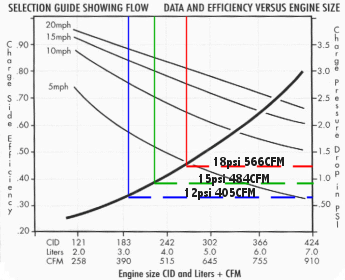

|
Street Class Unlimited Class
DOHC SOHC Ion Updated 1/05 For the most recent list of the fastest five cars click here. |
Intercooler Sizingby: Titan
|
|
RPM |
lbs/min |
CFM |
|
2000 |
3.94 |
57.10 |
|
3000 |
5.91 |
85.65 |
|
4000 |
7.87 |
114.06 |
|
5000 |
9.84 |
142.61 |
|
6000 |
11.81 |
171.16 |
Now take the CFM above and multiply it by the pressure ratio of your desired boost level.
|
Psi |
Ratio |
|
12 |
1.82 |
|
15 |
2.02 |
|
18 |
2.22 |
Example:
171.16 x 2.22 = 379.98 CFM uncorrected*
This shows that at 6000rpm and 18psi the turbo is producing an
uncorrected* 379.98CFM
*By uncorrected CFM I mean that we have not made adjustments for
ambient air temperature, adiabatic efficiency (A/E), or air density
ratio.
Now, using part two of the article deciphering turbo compressor
maps find the air density ratio at an ambient temperature of your
choice and multiply it by the turbo’s uncorrected airflow
value.
Example:
379.98 x 1.49* = 566.20CFM (corrected*)
*Air Density Ratio using 80oF, 74% A/E, and 18psi
Corrected Turbo Airflow Output in CFM
80oF and 74% A/E
|
RPM |
12psi |
15psi |
18psi |
|
2000 |
135.09 |
161.51 |
188.94 |
|
3000 |
202.72 |
242.26 |
283.32 |
|
4000 |
269.80 |
322.60 |
377.25 |
|
5000 |
337.43 |
403.36 |
471.62 |
|
6000 |
404.88 |
484.11 |
566.20 |
90oF and 74% A/E
|
RPM |
12psi |
15psi |
18psi |
|
2000 |
134.05 |
159.20 |
186.41 |
|
3000 |
201.17 |
238.80 |
279.51 |
|
4000 |
267.72 |
318.00 |
372.19 |
|
5000 |
334.84 |
397.60 |
465.29 |
|
6000 |
401.77 |
477.20 |
558.60 |
You can see that there is a trend developing between the two tables. As the ambient temperature goes up less air is being pumped into the engine, which makes sense since air because less dense as the temperature rises.
Below is a graph of a Spearco bar and plate intercooler (part #
2-116). This intercooler has a flow rating of 645 CFM and can support
430 HP. The intercooler's dimensions are 13.6W x 11.75H x 3.5D.
The data points below reflect 6000rpm values taken from the corrected
turbo airflow table above (80°F and 74% A/E). The scale on the
right hand side of the graph measures pressure drop across the core
while intercooler efficiency at 5, 10, 15, 20mph is measure on the
left hand side. On the bottom of the graph is engine size. The engine
size may confuse you a bit. The Saturn has a 1.9liter engine but
looking at the graph we did not plot any of our data points even
close to that engine size. Turbo charging an engine artificially
increases the CID of the engine. So, instead of focusing on the
engine size it is more important to look at CFM.

In this example we will consider the green line which represents the efficiency of the intercooler boosting 15psi or 484CFM. On the graph there are two lines, a dotted line and a solid line. The intersecting point between these two lines, at the 90-degree elbow, is the corrected CFM data point calculated from above. Drawing a straight line down from this point will show approximate CID (220), Liters (3.7), and CFM (484) of the engine. The green horizontal doted line shows about a .9psi drop across the intercooler core at 15psi. The solid vertical green line is intersected several times by black lines each having a mph designation. These intersections show the core efficiency, on the left-hand side, at the given mph. At the intersection of these lines you can draw a line to the left and find the core efficiency. For example, at 10mph the core efficiency is .70 or 70%.
Solving for the corrected turbo airflow output of your turbo and then plotting the data on a graph will help you to reduce intercooler induced turbo lag brought on by a larger than required intercooler. By the same token it will save you from heat soaking to small of an intercooler.
I'll leave you with a few points to consider when choosing an intercooler
• Don't go overboard on the intercooler size. This can induce
intercooler lag, which is created when the turbo has to fill the
large space within the intercooler before it reaches the engine.
• Route the intercooler piping so it has the shortest distance
between the turbo and the throttle body.
• Mount the intercooler where it can receive a fresh supply
of air that passes directly over the fins.
• Make sure you have room for the intercooler. Measure everything
before you order so that it will fit.
• Keep pressure drops across the core to a minimum. Anything
under 1.5psi at full boost is considered good.
• It's better to have an intercooler with more height than
width. This means that the flow through the intercooler is vertical
not horizontal. (height is the charge side)

The turbosaturns.net forum has become one of the best resources for Saturn performance on the net. Our members are constantly pushing their cars to new performance levels. So, log in, share your ideas, and help push your car’s performance to the next level.

- Apexi Safc Install
- Turbo Tuning
- Cams 101
- Wastegate 101
- HP vs Torque
- Ian's Turbo F.A.Q.
- Oxygen Sensors
- DIY Fuel Regulator
- Taming Detonation
- Walbro Install
- Fuel Injectors
- Techedge Wideband
- OEM Fuel Pump Limits
- AVC-R Programming
- Dynosoft
- 220whp or Bust
Archived Articles
HERE
![]()
August 2005 TSN will be holding its first ever meet in Chardon, Ohio. Some of the fastest Saturns in the country will be attending. Activities will include drag racing, dyno, tech session, and BBQ. Look for the latest information in the forums.
Different Racing

Jeff and his team Different Racing have big plans on breaking into some really low quarter mile times this year. Last year he posted a 12.40 on a pretty healthy nitrous shot. This year he has a new turbo setup and some serious determination. Visit his website for the latest news and information. I expect we'll be seeing some low 12's from him by the end of the year.
